Behind the scenes of the renovation
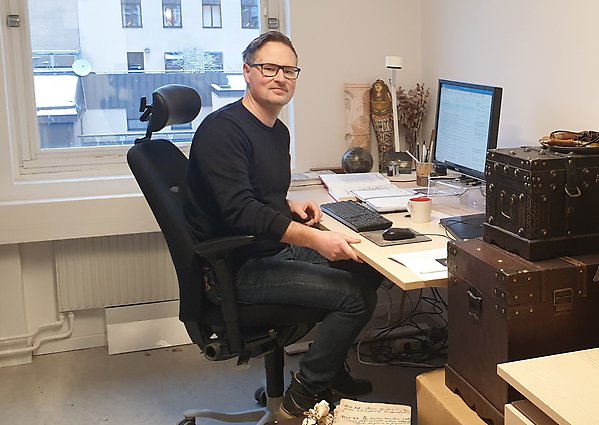
Hello Leif Hallsén!
You have been a museum educator at Gustavianum for several years now. Could you tell us a bit, about what you are currently working on?
I am working extensively on planning the new exhibitions at the university museum and on producing text for them, but I am also involved in designing a new guided tour and school program. We have been closed for a long time, but now it really feels like an opening is approaching and I am very excited to welcome visitors back to the museum. Personally, I find it particularly exciting to introduce the new museum to all the teachers and students we know are curious. You might mention that, in addition to exhibition work, you are also planning for upcoming school tours in the new Gustavianum.
So school classes and preschool groups will continue to be welcome at the new Gustavianum?
Absolutely! Gustavianum was already a museum that was visited by many schools, from preschool all the way up to high school. When we reopen, it will be with new and more exhibitions, which means the museum will feel interesting and relevant to even more teachers and students than before. Uppsala University's collections are absolutely fantastic, and there is truly something for every teacher and student, regardless of age or the subject they are interested in. However, they will have to wait a little longer. We welcome school classes starting in the autumn term of 2024. However, during the spring, you can already check Gustavianum's website to see what the school program looks like. You might mention that it will be available from the autumn term of 2024 and that more information will be published on the web in the spring.
But is there no opportunity to access Gustavianum's school offerings right now?
Together with the university museums in Tartu and Helsinki, we have developed an educational resource that we call the "Student Chest." It is a physical chest with objects that teachers can borrow for their classrooms starting from the spring semester of 2024, completely free of charge. Through the chest and its contents, students can learn in an exciting way about what life was like in 17th-century Sweden. Would you like to borrow a chest for your class? Learn more here: School and preschool
Hello Anna-Zara Lindbom!
You are an antiquarian at Gustavianum and responsible for the history of science collection at Gustavianum. What kind of scientific objects does the university actually manage, and what is their purpose today?
The objects in the history of science collection vary greatly as they come from different fields of science. The collection includes many instruments from the natural sciences, but also older weapons, measuring tools, weights, folk objects, African small animal traps, in other words, anything that has been used in research and education. The oldest instrument dates back to the 16th century, and the youngest is from 1981. The most famous item is Celsius' thermometer, where he first wrote his temperature scale. Today, the collections are open to researchers as well as students working on their theses. Students can also intern with us and learn how antiquarians work in their daily tasks. We document and digitize the collections to make them more accessible. Another important task is to preserve the objects for the future.
Will objects from the collection be displayed in the new Gustavianum?
A selection from the history of science collection will be displayed in the new museum. Both unique objects and those used in the researchers' everyday work have been chosen. We really want to highlight the vast diversity of knowledge that has been shaped at the university. It hasn't been easy to choose from among several thousand exciting objects, but I am satisfied with our selection.
What is your role in the exhibition work?
The selection process was the first step, followed by research on both the objects and the people who have been active at the university. The antiquarian's task is closely related to the objects, so there has been a lot of weighing and measuring. The objects must fit into the display cases. I have also written texts about the objects. Soon, the final phase will begin when everything needs to be carefully packed, transported, and installed in the new exhibition."
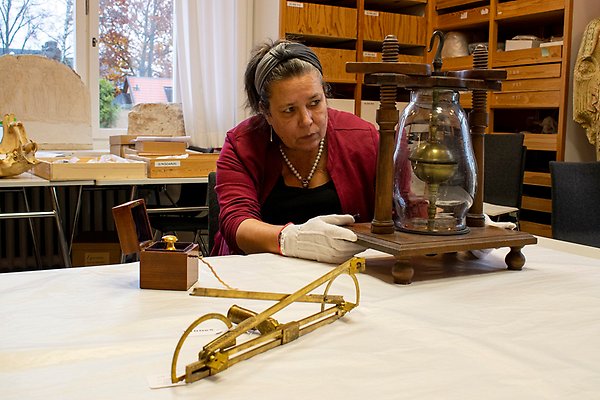
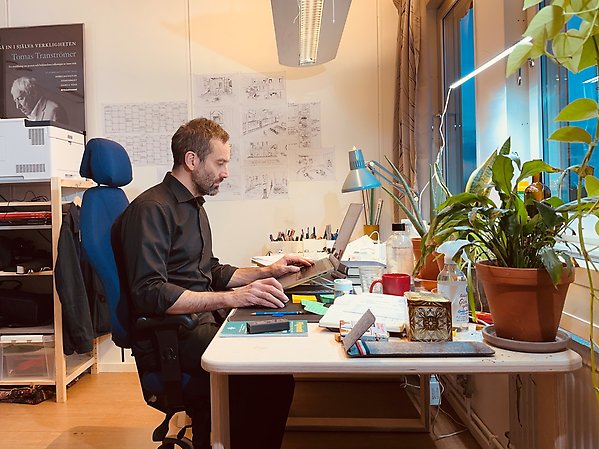
Hello Fredrik Skog!
You are the scenographer responsible for the new University history and history of science exhibition. What does that mean?
Hello! It means that I have developed a concept for the content and form of the new exhibition, in close collaboration with the exhibition group at Gustavianum. This has evolved in several stages, with workshops, meetings and discussions. Together, we have created the structure of the exhibition and its story, and selected which objects will be displayed. It has been a bit of a challenge because the exhibition space is divided into several smaller rooms. But I think we have found a really good solution! We are now in a phase where we have produced a first draft plan for exhibition cases and their contents.
Is it true that you also helped produce the University history exhibition that opened in 1997?
Yes that’s right! During my final term of Cultural Studies, I did my internship at Gustavianum. I started the internship in the spring of 1997 and the museum opened in mid-June of the same year. So it was just in the final stages of production and quite busy. I visited the various archives and collected together the objects, pictures and other materials. I was also involved in the actual building of the exhibition, the installation of the exhibition cases and arrangement of objects and texts. After the opening, I was allowed to stay on as a guide, but also produced several temporary exhibitions until 1999, when I left. I think the museum has lasted very well, but it is great fun to be able to come back and ‘update’ the exhibitions - 25 years later!
What do you think visitors will think of the new Gustavianum?
I think that those who have visited and appreciated the museum before will find it familiar, but will also discover many new, exciting features. The general narrative is the same, but we also highlight stories and objects that have not been included before. In terms of the overall look, we have reused several of the old exhibition cases, but rebuilt them so that they fit into the new exhibition. We are also producing a lot of digital material in the form of slideshows, films and texts, which will enable visitors to dive a little deeper into the stories. I hope that both old and new visitors will feel that it is an exciting and interesting exhibition, which feels modern and at the same time rooted in the stories it tells and in the unique environment provided by Gustavianum.
Hello Monika Frelin!
You are exhibition designer/scenographer for one of the new exhibitions in Gustavianum. This exhibition was first produced as a travelling exhibition to tour museums in the USA. Now you are updating the content for the new Gustavianum.
Yes, that's right, there are new storylines to include in the exhibition and we are moving the focus to the site of Valsgärde. The Vikings Begin primarily highlighted travel and trade to suit an international audience. Now that we are back in Uppland, it feels fitting to highlight this fantastic site, its boat graves, and life in and around Valsgärde. It is also relevant to describe the 20th century excavations because visitors to Gustavianum can continue on to Gamla Uppsala, where they can experience the stories there.
The exhibition has been produced in close collaboration with researchers at Uppsala University. What form has this collaboration taken?
We have had meetings with the researchers in Uppsala, and we who work with the exhibition have access to and read the researchers' publications and other relevant literature. The researchers have contributed with suggestions about what to include and possible themes, and are responsible for the final review of content.
What is the difference between producing a travelling exhibition and a permanent exhibition?
Now that the exhibition is coming to Gustavianum, we are building for a longer lifetime: the exhibition does not have to be as flexible, but we have to consider that materials and techniques must be durable over a long period of time. A touring exhibition need to be robust enough to be repeatedly dismantled and rebuilt, but it will not be in place for decades, as a permanent exhibition could be.
What relationship do you have to the objects that will be shown in the exhibition? As an exhibition designer, you must spend a lot of time with them during the process of creating the displays and lighting.
The Valsgärde items are absolutely amazing! It is a privilege to have the opportunity to get up close to objects that are both unique and well-preserved. We work closely with the Museum's Senior Conservator Emma Hocker and colleagues, who are responsible for all handling of, and knowledge about, the objects. Our mission is to put them in a context that feels both exciting and comprehensible.
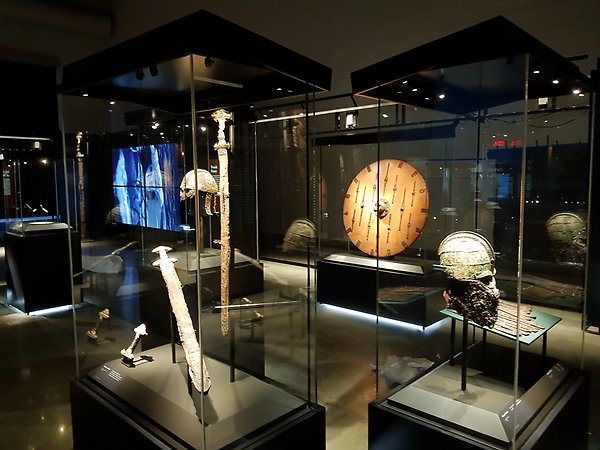
Picture from the traveling exhibition The Vikings Begin in the USA.
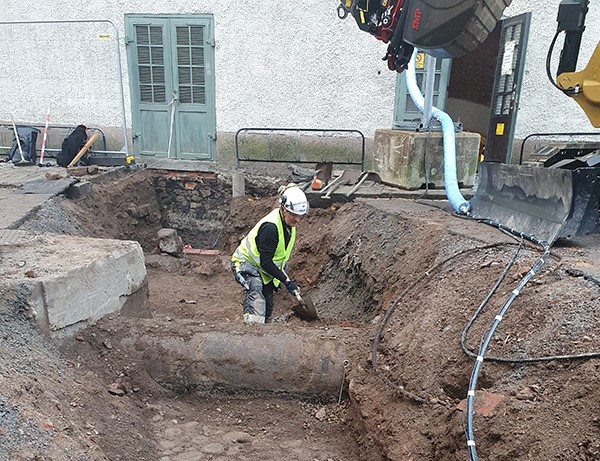
Robin Lucas clears remains next to Gustavianum's north gable. In the foreground you can see a medieval wall and beyond it an older paving, probably belonging to Rundelsgränd, which earlier had its route here. Photo, Adam Hultberg, Upplandsmuseet.
Hello Robin Lucas!
You are an archaeologist at the Uppland Museum and responsible for the excavations carried out at the Gustavianum during the last few months. Why have these excavations been necessary?
The investigations were necessary because the National Property Board is carrying out an extensive renovation of the Gustavianum. In connection with the installation of air conditioning systems, new pipes had to be drawn into the Gustavianum. My colleague and I followed when the larger lines were buried. Remains in Sweden that were added before 1850 must be examined by archaeologists in the event of ground invasion. At the Gustavianum, we already know that there are older remains. In addition, the entire area is within the limits of Uppsala's medieval settlement, which constitutes an ancient relic in itself. The National Property Board applied for permission from the County Administrative Board, which in turn contacted an excavating institution - the Upplandsmuseet.
What have you found during your work?
We have found remains from at least three different house constructions and loose finds in the form of coins and ceramics. At the north gable of the Gustavianum were the remains of a medieval building. A little further north in the same shaft we found remains of a road surface. Older maps show that Rundelsgränd was located here until Universitetsparken was laid out in the 1880s. On the other side of the road, towards the Ekerman house, we found the parts of a strong vault which was probably the entrance to a cellar in another medieval building. When we then continued the excavations, we found on the western long side an almost meter high wall in an L shape that continued under the Gustavianum. The wall probably formed the corner of a medieval building that was demolished when the Gustavianum was built. It may have been part of the Little Archbishop's Farm. Further south there was another wall which probably formed the inside of the free staircase that had previously been here. It was an external stairwell that was built in connection with the construction of the Gustavianum and is depicted on older copper engravings.
How will the excavations be documented and will we be able to see the smaller finds in the future in some museum?
Now that we are finished with the field archaeological effort at the Gustavianum, new work begins. The archaeological remains must be analyzed in relation to the historical information available about the Gustavianum and photos and finds must also be recorded. All results will be presented in a report on Upplandsmuseet's website in the fall of 2023. Whether we will see some of the objects that were found on display remains to be seen, but they will definitely be made available via Digitalt Museum.
Hello Jacob Hidemark!
Your firm - Hidemark & Stintzing - is mainly responsible for the architectural strategy behind the renovation of the Gustavianum. What does that mean concretely?
This means that we have been responsible for the design in the parts affected by the renovation. The strategy has been a balancing act between aesthetics, function and antiquarian positions. As both house architect and responsible architect, you have to treat the building humbly, throughout the entire process, as Gustavianum is completely unique. We have been involved in the project from an early stage and have thus had the opportunity to learn about the house from the ground up. A project matures little by little through the design and solutions are discussed, developed or rejected.
As we have already pointed out, the Gustavianum is not just any building. What challenges are there in this project?
The Gustavianum is a state building monument and that means it is protected from excessive changes. The biggest challenge has therefore been that the additions and changes that are a consequence of the technical installations, such as improved ventilation and fire protection, etc., should be visible as little as possible. Often, the requirements for, for example, a door section are contradictory between fire requirements, safety and accessibility. All requirements must be met, which requires thought and inventiveness, and designed in the best way for the given situation.
Through the years and previous renovations, new layers of time have been added to the story. What traces will the ongoing renovation leave behind?
The biggest change in terms of design is that we are creating a new main entrance on the west side of the building so that the museum will be accessible to everyone. The entrance level gets a new flow where visitors will be led directly into a new reception and museum shop and then move on to the exhibitions. Externally, the entrance advertises itself with a new glass double door made of copper and a canopy that protects against rain.
In the stairwell, there will be additions in the form of new wrought iron gates and additions to the railings, which interact with the design from John Way's remodeling in 1842, when the black oil-burnt wrought iron in the railings and handrails was added. The graphic effect these provide is enhanced and developed through the now upcoming additions.
Is it true that you Jacob were also involved in the last renovation of the Gustavianum in the 1990s?
As a young and recently graduated architect, I worked for a few years with my father Ove Hidemark, who was responsible for the rebuilding during the 1990s. I was deeply involved in the work on the Gustavianum and made a large number of drawings that came to fruition. That rebuild has held up very well and very little from it will change. It is something that can be compared to a déjà vu feeling to return to a project after so many years and see things that I helped draw long ago. It also provides an excellent opportunity to evaluate what worked well and what may need to be redone.
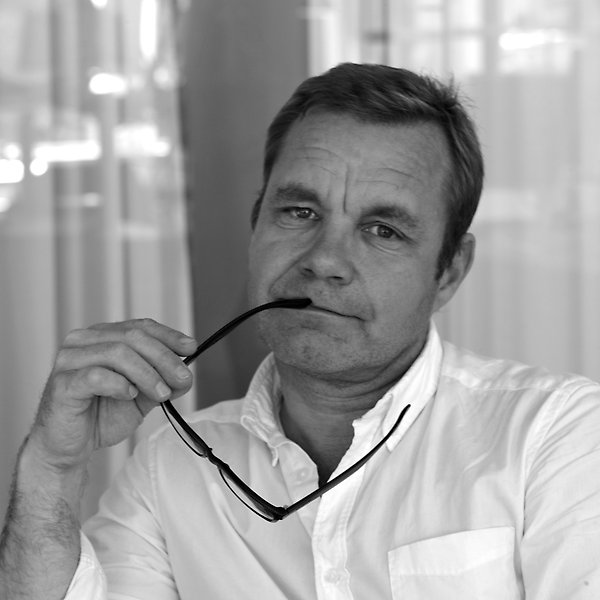
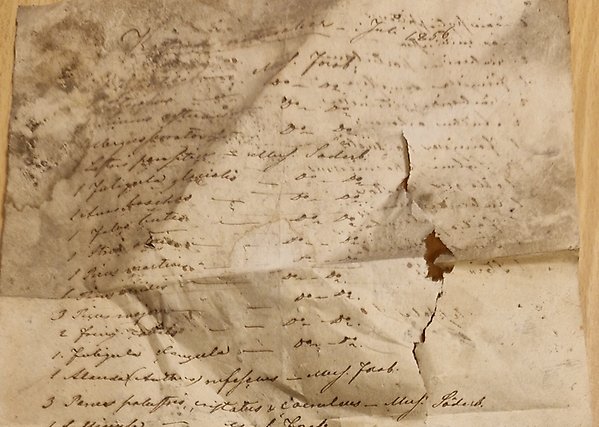
Wilhelm Lilljeborg's handwritten document.
Beneath the floor in Gustavianum
In connection with the renovation of the Gustavianum, a handwritten document from the year 1856 was recently found under the floorboards in the south attic. The document was sent to the historical collections where, upon closer examination, it turned out to be a list of "discarded natural materials" which appears to be signed by Wilhelm Lilljeborg. This is interesting because Lilljeborg, born in 1816, in 1854 became the first professor of zoology at Uppsala University. With this, zoology got premises in the Gustavianum where the collections from the Linneanum were moved, something that could contribute as a background to the decision in 1856 to dispose of some of the objects. Mats Eriksson, museum director at the Museum of Evolution, says that much of the zoological collections were also in very poor condition at this time and that large parts were probably discarded even before Lilljeborg's accession.
The list seems to consist primarily of various Swedish bird species, ranging from, among other things, Falco palumbarius (pigeon hawk) to Anthus arboreus (tree lark). There are several specimens of certain species and some of these, says Eriksson, are still in the Evolution Museum's collections today.
Archaeological investigation at the Gustavianum
During the fall of 2022, the Uppland Museum's archaeologists have begun an archaeological investigation at the Gustavianum. In connection with the ongoing renovation, and that air conditioning systems are to be installed, new pipes needed to be drawn into the Gustavianum. In the deep shaft dug for this work, the archaeologists found remains of two medieval house structures, 17th century coins, animal bones and medieval pottery. The investigations were paused, but they will continue again in early 2023, then with excavation work inside Gustavianum's basement. Robin Lucas from the Uppland Museum will be the archaeologist in charge.
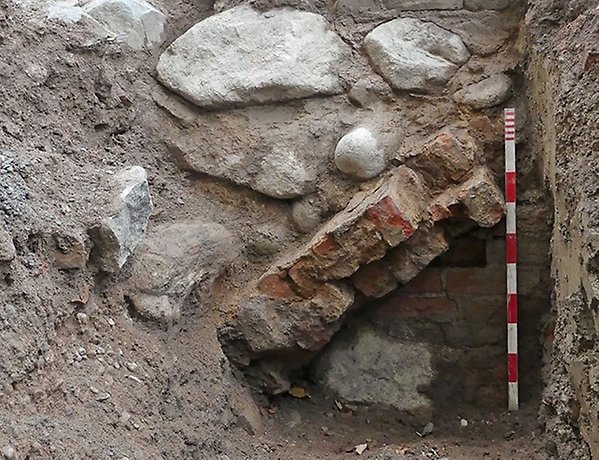
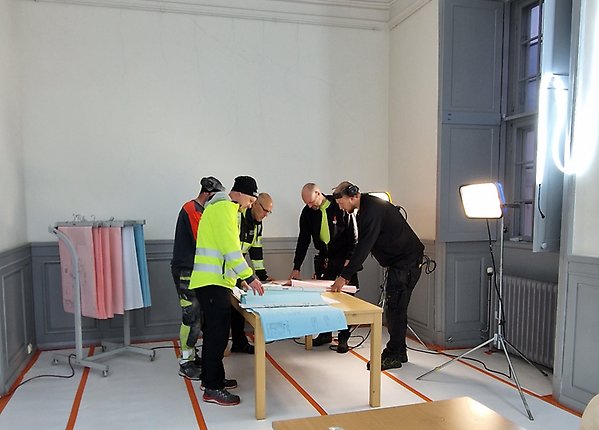
Hello Pär Karlsson!
You are CEO at ByggConstruct. You have just moved into Gustavianum. What is your role in the ongoing renovation?
It is about coordinating the renovation from start to completion. It is extensive work in a special building. Our role as general contractor is to lead and run the project with our craftsmen and installers. It requires a large portion of good cooperation between ByggConstruct and the Statens Fastighetsverk. At the same time, it is very challenging and stimulating to work with old historical buildings.
Is it true that you are also responsible for the ongoing renovation of the Church's house?
Yes it is true! The renovation of the Church's house has been underway for a long time. But now it coincided in terms of time. We see this as an advantage, as we can quickly and easily support with resources between projects. This mainly applies to resources in the form of craftsmen and knowledge.
Do you have memories of previous visits to the Gustavianum?
It is the anatomical theater that first appears as a memory. Then I'm a bit "occupationally injured" and like the fine limestone floors in the stairwells.
Work on the new exhibitions in the Gustavianum is in full swing.
Researchers, museum colleagues and students participate in the work of writing texts for the objects to be exhibited. One of these researchers is Gustav Berry.
What is your thesis about?
My dissertation work is at the intersection between agricultural and educational history. I am researching female agricultural and household education during the 20th century and my thesis explores why so-called rural household education was carried out. In the thesis, I show that rural household education was designed to deal with the problems that arose in connection with rural depopulation, and that rural household education was given this framework by a group that felt threatened by the rapid and powerful transformation the countryside underwent during the first half of the 20th century.
What is your relationship with museums?
Through various jobs at museums in Sweden and Norway before starting my PhD, I have primarily come to associate museums with work, even though I am also a reasonably diligent museum visitor. Reflexively, I also think of knowledge when I think of museums. For me, museums are inalienable institutions of knowledge that both manage and create knowledge.
What did you think of the assignment?
Being able to contribute to the development of knowledge around the Gustavianium's collections by writing a micro-narrative about an object has been a very fun assignment, and a thought-provoking task for me as a researcher. On a daily basis, I don't work with material objects. Therefore, trying to tell the story of an object was a challenge. But the assignment gave me new perspectives on how multifaceted such an everyday object as a washing machine can be. It also provided a very solid understanding of the past that is rarely present in the written source material I am used to working with.
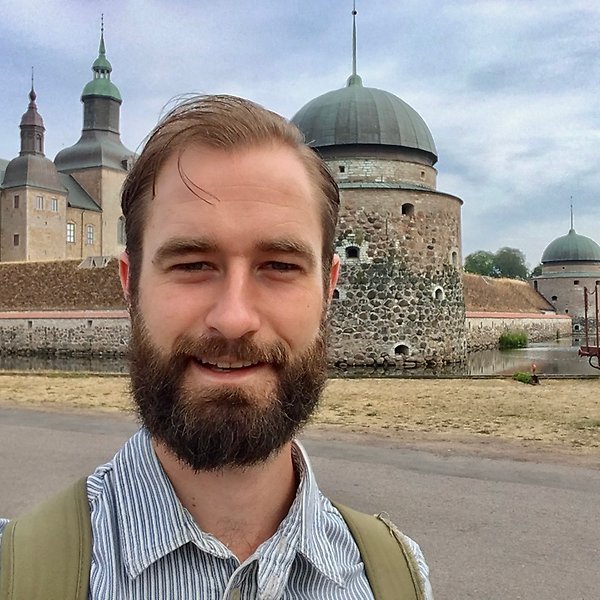
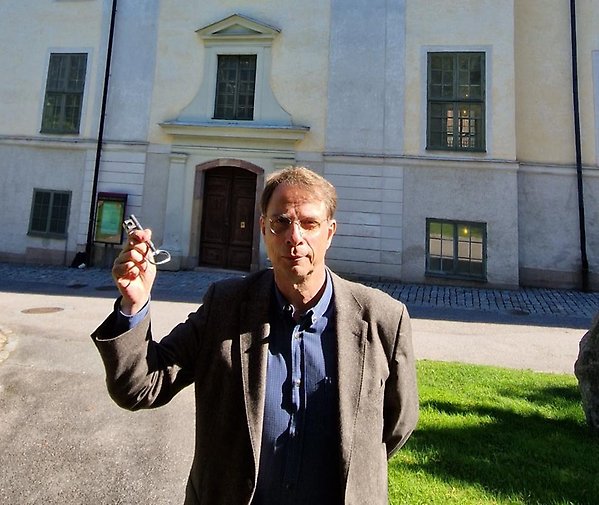
The renovation of the Gustavianum continues!
Now in the fall of 2022, the project enters a new exciting phase, where work on the house starts at full speed. The National Property Board (SFV) now takes over the responsibility for the building and under their supervision, a series of different steps begin – with electrical installations, security upgrades, installation of lighting and air conditioning systems – and finally the renovation of all floors and surfaces. So a project that involves expertise and solid craftsmanship in a wide range of areas. At the same time, the museum's own staff continues with the preparations for all the new exhibitions that will fill the newly renovated Gustavianum. With the sights set on a reopening in early 2024.
Examination of Gustavianum's sundial
In connection with Gustavianum's ongoing renovation, the sundial has been examined. Do you know how a sundial works? Since the earth rotates on its axis in 24 hours, it appears as if the sun is moving from east to west. Therefore, shadows will also move during the day. When the sun shines on the dome's sun globe, half of the globe is illuminated. The other is in the shade. The line between light and shadow moves around the ball, and it is the position of the line on the ball's scale that shows the time. Try reading the sundial yourself on a sunny day. Compare with the cathedral if you feel unsure. Remember that there was no summer time in the 17th century.
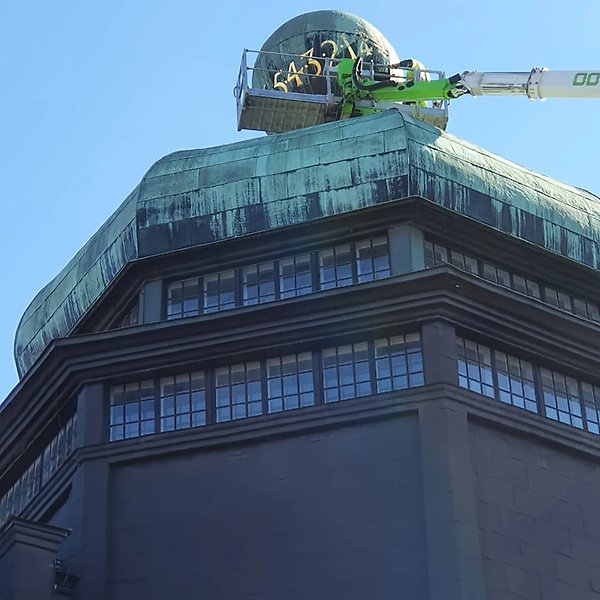
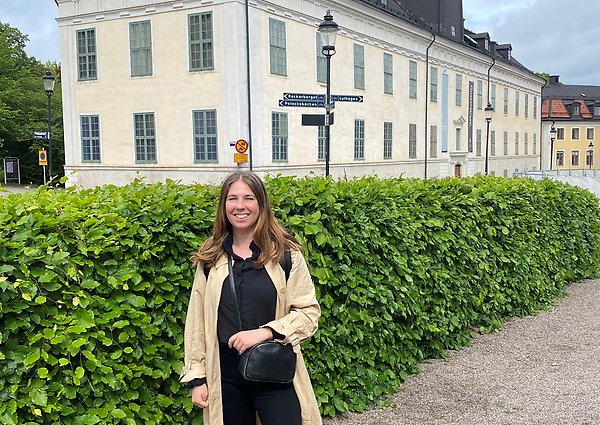
Hello Hanna Wistrand, project manager at SFV!
What is your role in the ongoing renovation project?
I am one of two project managers from the National Property Board (SFV), my role is assistant project manager. Many specialists are involved in Gustavianum's renovation.
What does the distribution of responsibilities look like?
A large number of people are involved in the project, both consultants and internal specialists at SFV. The consulting group consists of just under 20 people in various disciplines. Internally from SFV, we have involved about ten of our technical specialists and cultural heritage specialists.
The distribution of responsibilities is fairly clearly divided between the various specialist areas (e.g. Environment, Electricity, Cultural Heritage, Plumbing, Architecture, etc.) where each consultant takes responsibility for his part.
The Gustavianum is not just any building. What function do you think the house will have in 100 years?
My hope is that even then it has to do with education in some form. Would be great if it is still possible to visit the building and anatomical theater as a private person.
Hello Fredrik Eriksson!
You have an important role as coordinator and support for Gustavianum in the currently ongoing renovation process. What does a typical working day look like for you?
It varies depending on the projects I'm involved in. But most days involve a combination of planning meetings in the office and on-site work on the current construction projects. I help the clients with requirements, which concretely means that I have a dialogue with users, scenographers and architects before and during a renovation. Currently, I have assignments from two other museums and a university. Finance, technology and purchasing are three important functions. Often, the business has a good idea of what and where they want, but don't know how to get there. My mission will be to find a workable path to the end goal, while at the same time questioning and developing new ideas along the way.
You were the project manager for the National Museum's renovation. What is the biggest challenge in renovating historic buildings?
To succeed in raising the quality of the business with the limitations/opportunities that exist in historic buildings. Visitor flows and logistics often look different today than just a few decades ago. It is therefore important to get a historic building like the Gustavianum to work in the same direction as the activities housed in the building in the form of exhibitions, shops and program activities. In my opinion, the visitors should perceive the building and the museum activities as a unit. Then the visit usually becomes more interesting from several perspectives.
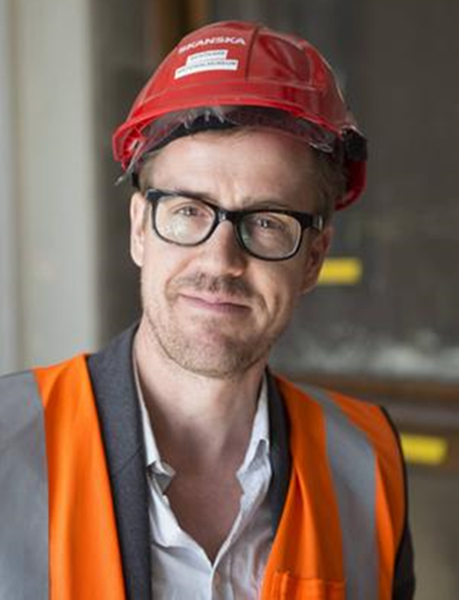
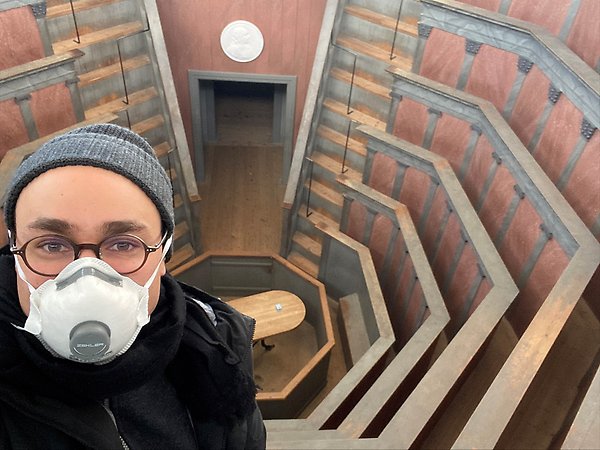
Hello Max Laserna!
You are a building antiquarian with assignments from SFV (The National Property Board). What is your role in Gustavianum's ongoing renovation?
The Gustavianum is, after all, a unique building that is protected as a state building monument, which means that you need to apply for permission from the The Swedish National Heritage Board for all changes. My role is to be an antiquarian participant in the project. During the planning, this means that I am a support for the architects and technical specialists to find solutions that can be implemented without the building's cultural-historical values being lost. It can be about everything from finding a good route for a pipe laying to being involved in developing suitable lighting for the stairwell.
What does a typical working day look like for you?
The usual thing is probably that it is very varied. In the morning it can be office work or a meeting on a construction site, while the afternoon is spent examining an old truss or perhaps how a door was originally painted.
Have you found anything exciting during your work at Gustavianum?
Gustavianum is a very exciting building with a long and complex building history to say the least. We haven't started the actual construction yet, but we have learned a lot about the house. For example, we have found a lot of blocked openings and cavities that we are trying to use in order to avoid making unnecessary new interventions in the building. Most interesting, however, was to examine a part of the heart wall that we didn't really have a clue about. The masonry is very uneven there and appears to have been part of it. We think it is because the wall was damaged during Gustav Vasa's attack and siege of Uppsala in 1521 when the farm was ravaged by fire. It is said that Gustavianum, which was then Bishop's Farm, was then left deserted for almost a hundred years. Another interesting discovery is that we believe that part of the black plate still sitting on the lower part of the dome may be original, from the 1660s. It is one of the oldest exterior sheet metal coverings I have come across!
New home for inventory
When Museum Gustavianum was inaugurated in 1997, chalkboards were still used in the university's lecture halls. Technology and needs have changed since then. In the currently ongoing renovation, Gustavianum wishes to reuse the fixtures that do not fit in the updated university museum. The old chalkboard from Auditorium Minus will find a new home at the Glinet preschool in Luthagen, Uppsala.
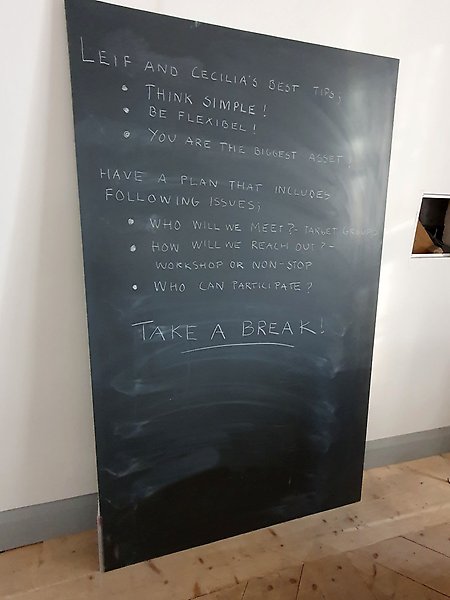
The slate from Auditorium Minus.
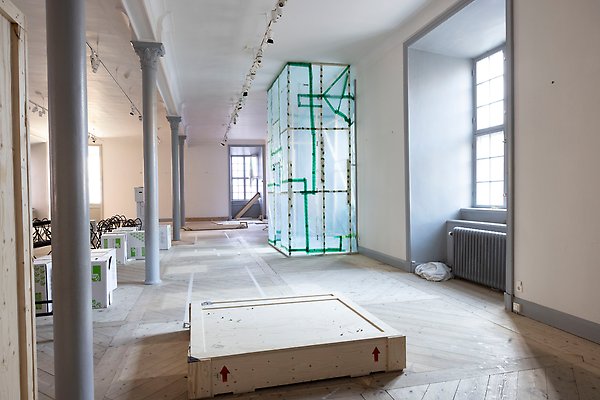
An update: What's going on?
Gustavianum has thus closed its doors for the ongoing renovation. The goal is to create a more professional and efficient museum with new exhibitions, with a controlled climate that makes the objects feel good and with security that meets today's requirements.
But why does it have to take so long?
The renovation is a long-term project that requires meticulous preparation. The building itself is an important historical monument, and the renovation must of course be done with the greatest antiquarian care. At the same time, extensive technical investigations of the building are required for the planning of all the functions required in the new museum.
What also needs to take time is the cooperation between different actors that is necessary for a complex project like this. It is about time for meetings and discussions between the university, The National Property Board, The Swedish National Heritage Board and a number of different architects, experts and consultants. All so that the planning will be the very best.
Parallel to that, the collections need to be conserved and cared for before the new exhibitions, where new stands, new lighting, new texts and digital presentations will be included.
And the result of these efforts and endless series of meetings is a document with thousands and thousands of details needed for the result to be as good as possible.
When will the museum reopen?
The museum will open in late 2023 or early 2024. And then we'll welcome everyone back with a series of spectacular new exhibitions. See you then!
Hello Emma Hocker!
You are the first conservator at Gustavianum and responsible for the evacuation of the museum. How do you pack down the contents of an entire museum?
It may seem like a huge and insurmountable task, but it really wasn't. As the previous exhibitions were thematically arranged, it was logical to pack and transport room by room with the responsible antiquarians on site to facilitate and ensure the process. We also had help from a number of student interns.
From past experience packing and transporting items, we knew it was better to have a smaller number of skilled people packing than a larger number of volunteers. Before we started packing, I organized a couple of practice sessions on how to pack items safely, what packing materials to use and why. For example, there is less risk of damaging items if they are placed in a small "nest" of packaging material rather than packing in multiple layers of paper.
How many items did you pack?
Oh, what a difficult question! I know I counted over 1000 objects from the Classical Archeology and Egyptology collections before we started. One of the complications was that some of the objects consist of a number of parts, especially the objects from the history of science collection. A scale with associated weights can either be counted as a single or multiple objects. I would estimate that we packed and transported more than 2000 items, maybe 2500 depending on how you count.
Which item was the hardest to pack?
Probably the center section of the art cabinet, as there were a number of carved and protruding parts that had to be protected with acid-free foam before being encased in a custom-built shipping box.
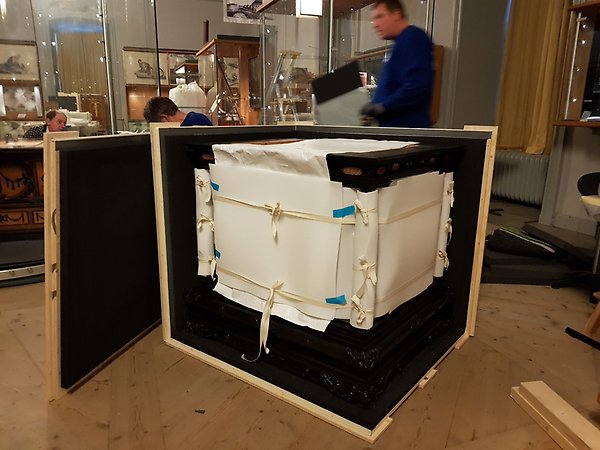
Mittdelen av det Augsburgska konstskåpet nedpackat.
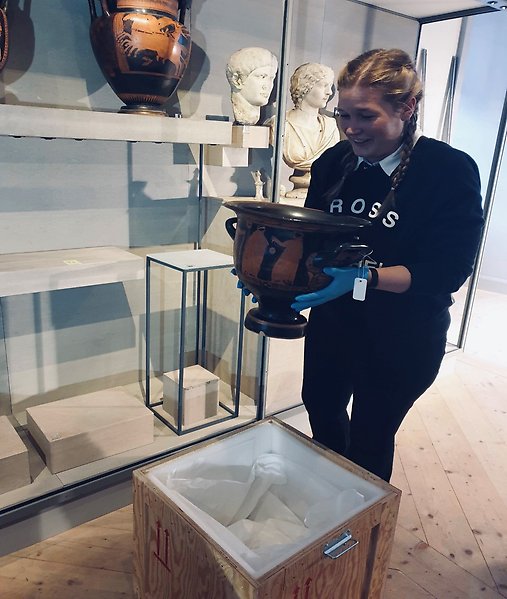
Packing of exhibits
Gustavianum's renovation began in autumn 2019 with the packing of all previously exhibited items. A time-consuming process that has required great accuracy and caution as the objects are in many cases very fragile. The Gustavianum has had the help of several talented master's students who did internships in the collection stores. One of these students is Cajsa Olausson, who studies humanities with a focus on ancient culture and social life.
What have you learned?
It is difficult to mention everything as there is so much! I have mainly been able to study the Nubian collection, which consists of vases, leather goods and bones, and I have learned to handle and digitize this material. I have gained an insight into how work at a museum works and what a future profession in the museum world would look like.
What has been the most fun during the internship?
The most fun has been being able to take part in the unpacking of the Mediterranean and Nile Valley exhibition. It was great fun handling and studying objects so closely. I now know what a mummy smells like!
